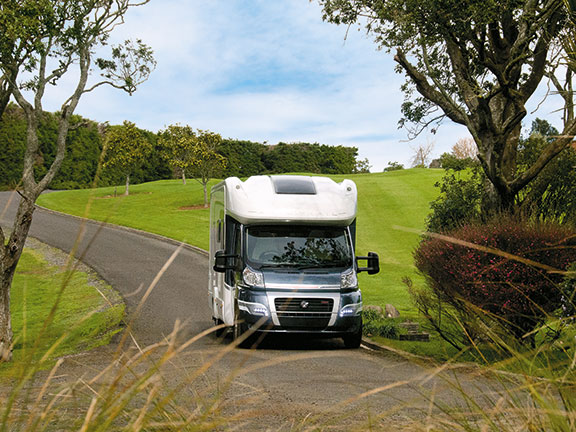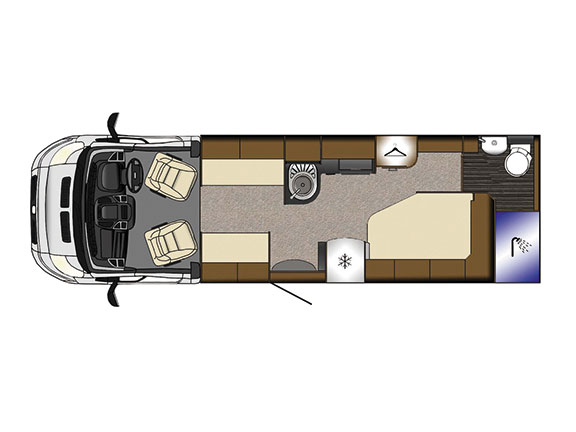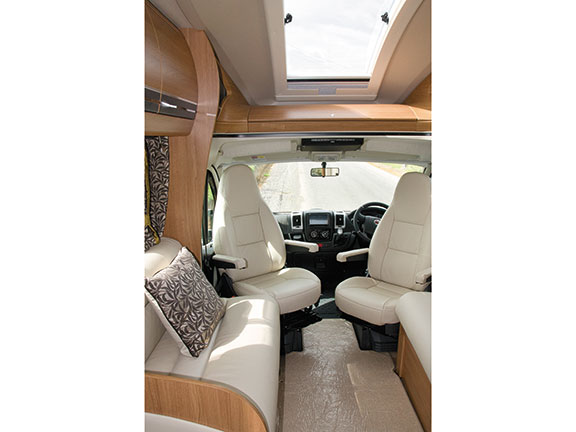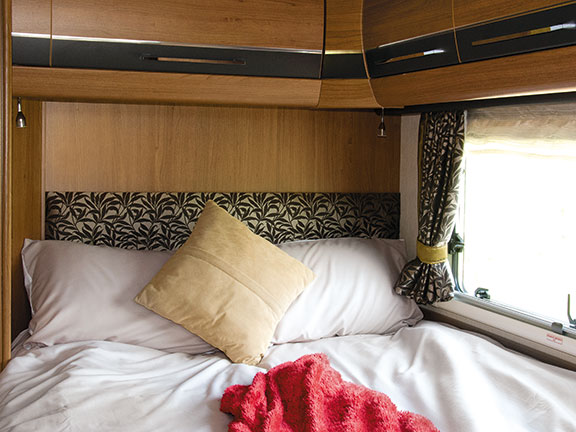Tracker, Apache and Frontier. No, it's not a billboard for a Saturday cinema matinee in the 1950s. These names identify the Auto-Trail motorhome range. Within these lines are a total of seventeen different models from smallest (the diminuitive Tracker RS at 6.1 metres) to the largest (the Comanche, Arapahoe and Chieftan at 8.73 metres). In the middle of the Auto-Trail field at 7.6 metres, the Frontier Dakota has, for Dan Monk at Auckland Motorhomes, been the standout performer. Earlier this month when I called to review another model in the range, Dan suggested we review the Dakota instead. "They've been so popular that they are off the boat and out to the customer before we get the opportunity to call MCD. Let's do it while we have the chance." Keen to see what made them so appealing, I was only too happy to oblige.
Decked out in carbon black metallic paint, grey graphics and fitted with low-level LED running lights (the Sport Line Pack) the Dakota with the super lo-line profile body is an eye-catching package. The coloured trim might cost a little more but the investment pays off because as well as the enjoyment gained by driving a very smart unit, almost invariably down the track, the resale price is better and it sells more quickly.
This attention to detail was evident inside and out. Auto-Trail has a reputation for producing carefully crafted products and there were many little touches that experienced motorhomers appreciate, like the golfer-sized umbrella lodged in its own housing in the habitation door; the fact it has a full-sized spare wheel stored under a retro-style cover on the back of the motorhome; and the dedicated cupboard for the heavy-duty plastic chopping board/sink cover. The wide, flat locker with the lift-up lid above the cab also caught my eye as a sensible use of space. It houses a small round table and pedestal that fits between the kerbside settee and cab seat, a sensible location clear of the access way between the settees. Another table, this one a large freestanding indoor/outdoor dining table, has its own storage compartment conveniently located right alongside the habitation doorway. The latest edition of windscreen and side window night- shades are another smart feature. Easy to deploy and folding away faultlessly, they provide privacy and shade the cab from damaging summer sun during the day.
The layout was different too, and I thought it worked well. It has a permanent rear corner double bed (kerbside) ahead of a full-width rear bathroom that contained one of the biggest shower recesses I have seen in a motorhome. The lounge is at the front and 'food central' is quite properly located in the centre of the motorhome.
A two-seater settee is placed on each side of the lounge and the rotating cab seats provide comfortable seating for six. These settees also convert into a second double bed, ideal for occasional hosting of companions on a weekend getaway. Just lift the settees to store the bedding — there's more than enough room. Above, the elegantly curved front hatch floods the lounge with light. A full-length blind offers shelter from mid-summer sun but at this time of the year sunshine in the lounge is a real bonus. The overhead lockers held a couple of surprises. The first was the 230/12-volt power supply uni — clearly labelled, logically set out, and reassuringly straightforward to use. The second was the liquor cabinet complete with bottle retaining clips and a set of four glasses.
The central L-shaped kitchen has all the mod-cons — full oven with separate grill, a large fridge with separate freezer, and a microwave. Not so obvious are the crockery rack in the locker over the sink, the dedicated cutlery drawer, and a small but cunningly space-efficient pantry slide-out that fits behind the sink. There is plenty of storage for groceries and greens with lockers above and below the fridge/freezer and under the sink. The L-shaped benchtop keeps the cook clear of the foot traffic passing by and is long enough to offer adequate food preparation space. Locating the fridge/freezer across on the other side of the motorhome has kept the sink/stove/fridge triangle compact and created an efficient working environment.
The Dakota interior is not only efficient — it is attractive, as well. The honey-coloured timber cabinetry sets off the cream Livingston leather seat upholstery that is complimented by the pewter 'dappled shade' pattern on bronze background curtain and cushion fabric. The fridge/freezer and the pair of sliding doors above it are finished in a matching shade of pewter.
Discretely tucked away between the kitchen bench and the wardrobe is a folding screen door that closes off the bedroom from the rest of the motorhome, allowing night-owls and early birds a degree of privacy at their respective ends of the day. The double bed — a foam mattress over timber slats — is a comfortable 1300mm wide and 1900mm long, but note, it does have a cutaway corner. The padded headboard provides added comfort when sitting up for your morning cuppa, but alas there are no shelves on which to place said cuppa. Directional reading lights are well-placed and comfortable. The generously proportioned hanging locker has three drawers and a locker below. Alongside is a small vanity, complete with mirror, make-up light, and a pair of cupboards below. With all these drawers and lockers (and four overhead lockers above the bed) there is no shortage of space for clothes and personal possessions. I like the fact the window alongside the bed has adjustment stays with tightening knobs. They seem to me to be much more secure, especially alongside one's bed, providing more security if left open at night. There is a roof hatch so, if you prefer, that can be your source of night time ventilation. Although TVs were not fitted in the Dakota as reviewed, there is a TV connection board on the bulkhead at the foot of the bed so fitting one for in-bed viewing should be straightforward enough.
Bathrooms in RVs must be getting better and better because in every recent review I have raved about how good the bathroom was. Well, this one is no exception. It ticks all the boxes — a proper door to seal off sounds and smells, lots of room, generous-sized separate shower stall, well-positioned toilet, water-efficient handbasin, all the shelves, hooks, and cupboards needed to put things in a place of their own, and a hatch plus window for ventilation. The only thing missing were towel rails. How did they miss that?
The Dakota is well insulated to the appropriate Euro standards so it will maintain an interior heat of 20˚C, even if the outside temperature drops as low as –20˚C. It has a Truman gas/230-volt heater that provides hot water and centrally heats the motorhome at the same time — two for the price of one.
Supplied by Auckland motorhomes, the Dakota comes with two 100Ah batteries and a 100-watt solar panel.
Now that I've reviewed the Dakota, I appreciate why it is so popular and why Dan was keen to have it reviewed.
As reviewed, the Dakota retails for around $168,000.
For the latest reviews, subscribe to our Motorhomes, Caravans & Destinations magazine here.

Review: JAC T9
For those passionate about adventuring with their caravan, one of the most important keys to success is a competent tow vehicle. We take a look at a newcomer to the market – the JAC T9.










